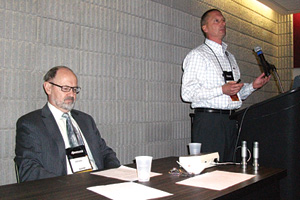
|
| A presentation on ammonia refrigeration systems’ pressure relief venting is given by William Greulich of Kensington Consulting. Seated is Brian Marriott, who moderated the Q&A portion of the presentation. |
The most recent International Institute of Ammonia Refrigeration (IIAR) Conference examined some of the latest research in terms of working with equipment running on natural refrigerants. The significance was not lost on attendees as such refrigerants continue to gain a foothold in commercial as well as the long-standing industrial applications. The June edition of FROSTline, The NEWS’ refrigerant e-newsletter, highlighted four of those papers. We now look at the remaining four. (All are posted in their entirety at www.iiar.org.)
Refrigerant Reduction
One ongoing focus of research with ammonia is to find ways to reduce its charge to allow wider applications. For Pega Hrnjak, president, Creative Thermal Solutions, and resident professor and codirector, air conditioning and refrigeration center at the University of Illinois, this reduced change encompasses what he called ultra low-charge ammonia systems.
He discussed strategies for charge reduction in compressors, vessels, pipes, and heat exchangers, with the focus on heat exchangers, and microchannel heat exchangers in particular. He also talked about the effect of mass flux on void fraction and needed manipulation of circuiting as part of the equation.
“Obviously, to reduce the charge, internal volume needs to be reduced, but the most important is to take in consideration effects of heat transfer balance and mass flux on void fraction.
“Special attention is given to explore and design a methodology for a fair way of comparing refrigerants based on their potential to be used in low-charge condensers.”
The paper also presented “a case for a small, low-charge, air-cooled ammonia chiller using microchannel condensers and hermetic compressor with miscible oil.”
“Microchannel air-cooled condensers, along with DX plate or similar evaporators, provided basis for low charge,” Hrnjak said. “In addition, the external volume of the chiller could be reduced because the external volume of a microchannel design is small. Besides being compact, microchannel heat exchangers are also made lightweight, from aluminum. Thanks for the technology developed in the automobile industry, these exchangers are relatively inexpensive.”
Pressure Relief Venting
William Greulich, process safety and risk management advisor, Kensington Consulting, presented on ammonia refrigeration systems’ pressure relief venting. For him, the issue was “pressure relief device performance affected by pressure drop in its inlet and outlet piping system.”
He noted, “Recognized and generally accepted good engineering practice and national regulations, codes, standards, and guidelines applicable to ammonia refrigeration systems require evaluation of these pressure drops and documented confirmation that they are within acceptable limits.”
To deal with this, Greulich said he used a specialized software application that can evaluate any ammonia refrigeration pressure relief vent piping system, including those with common headers. “The method is inexpensive, comprehensive, meets regulatory requirements, and follows recognized and generally accepted good engineering practices.
“Provided the ammonia refrigeration system design is well documented, with readily available as built isometric drawings and specifications for installed equipment, very little effort is required to comprehensively evaluate and document a relief vent system using the method presented here.”
It was also noted that the method captures code requirements including subsequent adopted reference standards such as ANSI/ASHRAE 15 and ANSI/IIAR 2.
Software Modeling
For Martin Timm, corporate process safety manager, Praxair Technology Inc., there needs to be an emphasis on dispersion modeling software.
“In recent years, changes in IIAR standards and model building codes have introduced the use of emergency pressure control systems (EPCS), which reduce the likelihood that pressures will rise high enough in the system to cause actuation of relief devices discharging into treatment systems or the atmosphere. But pressure relief valves are still required, and decisions must still be made regarding the best way to handle discharges from the relief valves.
“Modern dispersion modeling software can only estimate the concentration that results downwind when a material such as ammonia is released to atmosphere. Such modeling in this class is considered successful if field measurements of ammonia concentration match predictions within a factor of two to three. While the results are not highly precise, the analysis can still provide trends and insights that are useful to the ammonia refrigeration facility designer. In the future, the refrigeration industry should put more emphasis on placing the discharges at an orientation as well as elevation to minimize possible ammonia concentrations near ground level downwind from the release location, while still minimizing and controlling entry of water, dust, etc.”
Clothing
Proper clothing was a topic examined by Gary Smith, president, Ammonia Safety and Training Institute (ASTI) of Watsonville, California.
“The Ammonia Safety and Training Institute has evaluated current chemical vapor protective equipment through live ammonia testing and recommends that the original 5,000 parts per million (ppm) limit be increased to 15,000 ppm for Level B chemical vapor-protective clothing that meets degradation, penetration, and permeation standards.”
The research detailed the types of clothing that works best. “ASTI has provided evidence and related experiences that show alternative levels of personal protection equipment (PPE) — other than Level A — provide protection to the responder and an overall improvement of the health and safety concerns, especially when the risks and threats of wearing Level-A ensembles are considered. Level B provides more comfort, mobility, faster ability to don or doff the suit, and to change self-contained breathing apparatus (SCBA) air bottles, and less stress and physical strain on the emergency responder.”
Smith referenced his report by saying, “The availability of the use of Level-B PPE as described within this document will provide first responders with the ability to engage rapid entry rescue, a defensive mitigation strategy, and control small releases before they have time to develop into major life threatening events.”
Publication date: 6/30/2014
Want more HVAC industry news and information? Join The NEWS on Facebook, Twitter, and LinkedIn today!



Report Abusive Comment